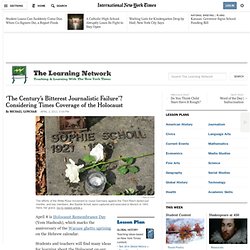

Fasansfull sanning om New Yorks slavar. Förr eller senare kommer sanningen alltid upp till ytan.

Förr eller senare hinner historien ifatt förövarna. I samband med ett bygge av en stor federal byggnad på nedre Manhattan 1991 gjordes en av nutidshistoriens främsta arkeologiska upptäckter, ett avslöjande som fortfarande i dag ger eko i det amerikanska samhället. Under lager av lera och ruiner av tidigare hus återfanns African Burial Ground, den begravningsplats som New Yorks slavar använde från 1600-talet då den transkontinentala slavhandeln tog sin början fram till 1794.
Här har uppemot 15 000 människor begravts. Människor helt utan rättigheter, människor utan namn eller historia. Deras öde är väl känt, men inte så här handgripligt. Inhumanismen i slaveriet är väl känt, men ändå inte så här tydligt. Det var ett ord som användes för att förtrycka och förslava. Mitt på golvet på museet ligger en tunna som jag prövar att skjuta uppför en planka, jag kan knappt rubba den. En sak fick dock slavarna göra – begrava sina döda. Animated interactive of the history of the Atlantic slave trade. Source: slavevoyages.org For the full interactive version, use a larger device.

Interactive by Andrew Kahn. Background image by Tim Jones. Usually, when we say “American slavery” or the “American slave trade,” we mean the American colonies or, later, the United States. But as we discussed in Episode 2 of Slate’s History of American Slavery Academy, relative to the entire slave trade, North America was a bit player. Seven Good Teaching Resources from the Library of Congress and the National Archives. Välkommen till Swede Hollow: en svensk slum. På satellitfoton och på Google Earth ser platsen ut som ett mörkt sår i stadslandskapet.

Modern History Remixed & Remastered. The Invasion of America: How the United States Took Over an Eighth of the World. First world war: 15 legacies still with us today. Poisonous gas The experiment began on 22 April 1915.

German soldiers, entrenched in the Belgian medieval town of Ypres, attacked with 6,000 steel canisters of chlorine gas. The wind carried the lethal gas, which was two-and-a-half times heavier than air, across to the British enemies, over a front that ran along some four miles. The gas caught the British soldiers unaware, killing 3,000 of them.
In no time all of the sides in the war started to set off their own gas attacks: it wafted over battlefields, made it over exclusion zones and wounded more than a million people, killing 70,000. French troops wearing an early form of gas mask in the trenches during the second Battle of Ypres in 1915. 101 Great Sites for Social Studies Class. 1.)

The Library of Congress is a great source to find historical documents, photos, art, maps, audio and video, artifacts and other items. The American Memory section organizes items based on topics, time periods and places of American history. The World Digital Library, a cooperative project with UNESCO, includes rare documents from around the world. 2.) The National Archives and Records Administration has a massive collection of material on U.S. history that can sometimes be overwhelming to search through. 3.) 3.1) EDSITEment "offers a treasure trove for teachers, students, and parents searching for high-quality material on the Internet in the subject areas of literature and language arts, foreign languages, art and culture, and history and social studies. " Free Streaming American History videos. Media History Digital Library - Online Access to the Histories of Cinema, Broadcasting & Sound.
Investigating New York Times Coverage of the Holocaust. Nancy KeilThe efforts of the White Rose movement to rouse Germans against the Third Reich lasted just months, and key members, like Sophie Scholl, were captured and executed in Munich in 1943.

Here, her grave. Go to related article » April 8 is Holocaust Remembrance Day (Yom Hashoah), which marks the anniversary of the Warsaw ghetto uprising on the Hebrew calendar. Students and teachers will find many ideas for learning about the Holocaust on our special resource page, which includes: This year, the 70th anniversary of the Warsaw ghetto uprising, we add one more idea: to use contemporary reporting in The New York Times itself as a lens for thinking about what the press was reporting at the time and why it was reporting it that way. Considering Times Coverage of the Holocaust Doing a search of Holocaust coverage in The Times is not an easy task. In “150th Anniversary: 1851-2001; Turning Away From the Holocaust,” Mr. Students should read the entire article. World History for Us All: Key Theme.
Home > The Three Essential Questions The Seven Key Themes The Three Essential Questions World History for Us All introduces three overarching thematic questions as guides for organizing classroom activities and discussions: Humans and the Environment Humans and Other Humans.

Fold3 - Historical military records. Se1. What is the State of the Union speech? 23 January 2011Last updated at 15:14 Woodrow Wilson revived the practice, begun by George Washington, of a spoken address The annual State of the Union address is the keynote speech by the president to Congress in which he sets out his agenda for the next year, highlights his accomplishments to the American people and shapes a political message.
